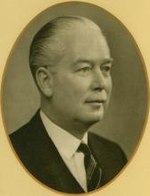Arthur Hartley | |
|---|---|
 | |
| Born | 7 January 1889 |
| Died | 28 January 1960 (aged 71) |
| Nationality | English |
| Education | City and Guilds College |
| Occupation | Engineer |
| Spouse(s) | Dorothy Wallace and Florence Hodgson |
| Children | four sons |
| Engineering career | |
| Discipline | Civil |
| Institutions | Institution of Civil Engineers (president), Institution of Mechanical Engineers (president) City and Guilds of London Institute (honorary fellow) |
| Projects | FIDO, Operation Pluto |
| Awards | Medal of Freedom |
Arthur Clifford Hartley, CBE (7 January 1889 – 28 January 1960) was a British civil engineer.[1] Graduating with a bachelor's degree from Imperial College London, Hartley worked for the North Eastern Railway and an asphalt manufacturer before joining the Royal Flying Corps during World War I. He became a qualified pilot, with the rank of major and joined the Air Board where he was involved with the development of interrupter gear. His war work was rewarded with his appointment as an Officer of the Order of the British Empire (OBE). He left the corps after the war and spent five years as a consulting engineer before he joined the Anglo-Persian Oil Company (later Anglo-Iranian).
During the Second World War Hartley was seconded to the government where he was involved in the development of the bombsight which sank the Tirpitz, the Operation Pluto pipeline project and the FIDO fog dispersion system. Following the war he was rewarded with an appointment as Commander of the Order of the British Empire (CBE), a United States Medal of Freedom and £9000 cash. He retired from Anglo-Iranian in 1951 and was elected president of the Institution of Mechanical Engineers. He was elected president of the Institution of Civil Engineers in 1959, but died three months into his tenure.
- ^ Vivian, A.C. (2004). "Hartley, Arthur Clifford (1889–1960)". Oxford Dictionary of National Biography (online ed.). Oxford University Press. doi:10.1093/ref:odnb/33740. (Subscription or UK public library membership required.)
